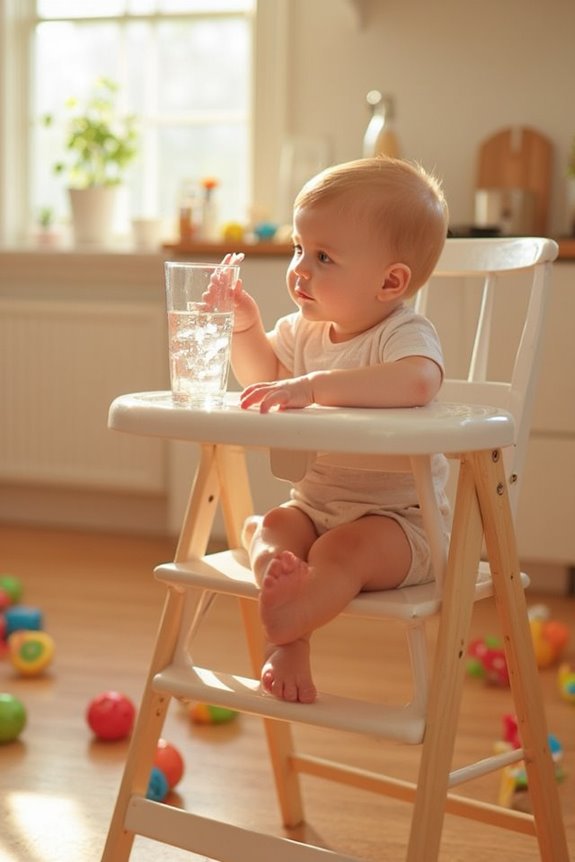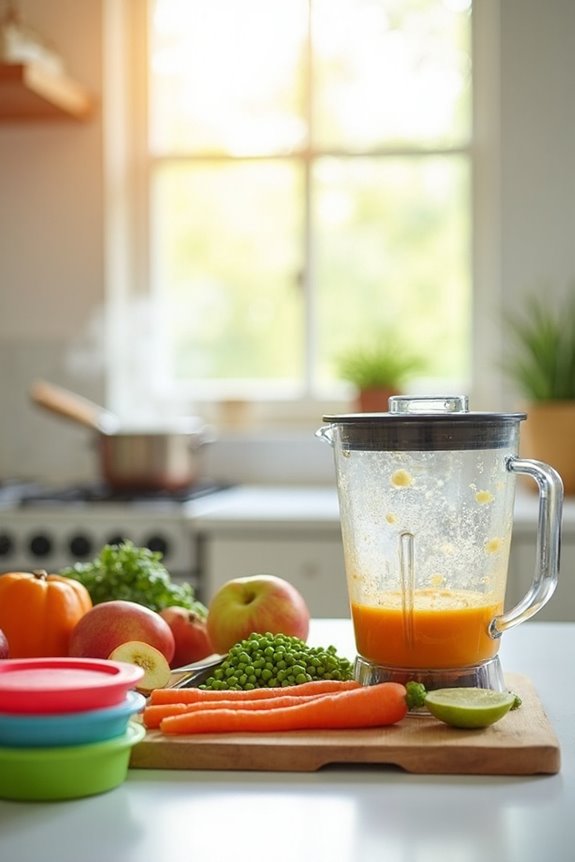We can safely introduce water to babies around six months, as long as they’re developmentally ready to handle it. Before this age, breast milk or formula provides all the hydration they need. Once you start offering water, aim for 4-8 ounces daily, gradually increasing it as your child grows. It’s essential to prioritize milk, ensuring water doesn’t replace it in their diet. We’ll cover more about hydration needs and methods for offering water next!
Key Takeaways
- Water introduction is safe for infants around six months of age when they can handle a cup.
- Start with small amounts of water to help infants acclimate to the taste.
- Infants under six months should not have water to avoid water intoxication risks.
- After six months, offer 4-8 ounces of water daily, adjusting as needed for toddlers.
- Always prioritize breast milk or formula as the primary source of hydration.
Understanding Hydration Needs for Infants
When we think about our little ones, it’s crucial to understand their hydration needs, especially since they’re growing and developing rapidly. Infants rely heavily on breast milk or formula, which generally fulfills their fluid requirements. As they age, we can incorporate hydration strategies to ensure they stay well-hydrated.
- Milk: It’s the primary source of infant fluid intake.
- Fruits and Vegetables: After six months, these can contribute around 20% of their hydration.
- Activity Level: Keep in mind that more active children may need additional fluids.
It’s important to monitor their hydration, as many don’t meet adequate intake recommendations. Staying informed about these needs helps us support their growth and health effectively.
Age Guidelines for Introducing Water
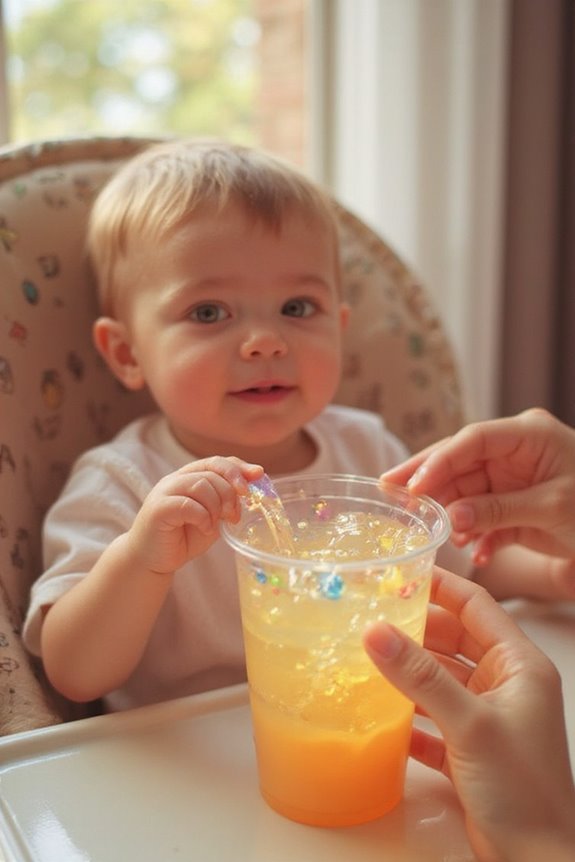
As our babies grow and start exploring solid foods, it becomes important to think about when to introduce water into their diet. Generally, the right time for water introduction is around 6 months of age, alongside solid foods and regular milk feeds.
Here are some key points to consider:
- Developmental Readiness: Ensure your baby can handle a cup before offering water.
- Introduction Method: Use an open cup or straw cup, avoiding bottles to promote proper drinking skills.
- Water Quantity: Start with small amounts to familiarize them with the taste.
Risks of Early Water Introduction

Introducing water to our little ones’ diets too early can pose several risks that we should be aware of. One significant concern is water intoxication, which can lead to hyponatremia, a dangerous drop in sodium levels. Since our babies’ kidneys aren’t fully developed, they struggle to process excess water, causing systemic overload.
Additionally, early water introduction can cause nutrient displacement, diluting the essential nutrients in breast milk or formula. This may lead to nutritional deficiencies, impacting growth and development.
We need to avoid giving water to infants under six months to prevent these risks. Monitoring for signs like confusion or drowsiness is crucial. If we have concerns, let’s consult our pediatrician for guidance.
Recommended Amounts and Frequency

Understanding the right amounts and frequency for introducing water to our little ones is key to ensuring their health and development.
For infants 0-6 months, no water is needed, as breast milk or formula provides all necessary hydration. Once they reach 6 months, we can offer 4-8 ounces of water daily, especially during mealtimes and snacks to help them develop their water preferences.
As our children grow into toddlers, we can gradually increase their intake to 8-32 ounces. Remember to monitor their hydration sources and ensure water doesn’t replace the essential nutrients found in breast milk or formula. Using open or straw cups can help them learn to drink independently while enjoying this new addition to their routine!
Best Methods for Offering Water
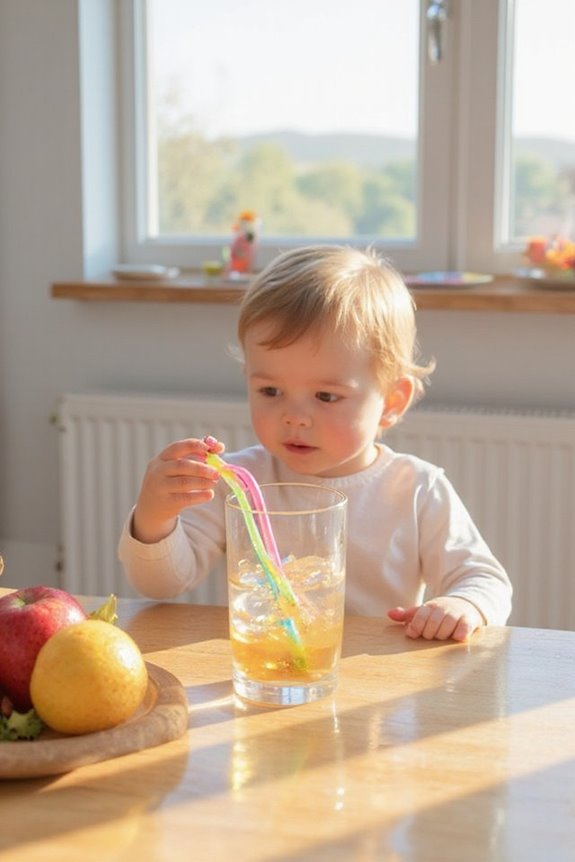
When it comes to offering water to our little ones, we want to make the experience enjoyable and safe. One of the best methods is using open cup techniques. This not only helps babies learn how to drink but also promotes their oral-motor skills. We can start with small amounts, around 1-3 ounces, to ensure they don’t overconsume.
Once they grasp drinking from an open cup, we can introduce the straw cup transition. Straw cups can be fun and encourage independent drinking. Opt for cups that are easy for our babies to hold and designed to minimize spills. By guiding them through these methods, we’re helping them develop essential skills for drinking water confidently in the future.
Safety Considerations for Infant Hydration
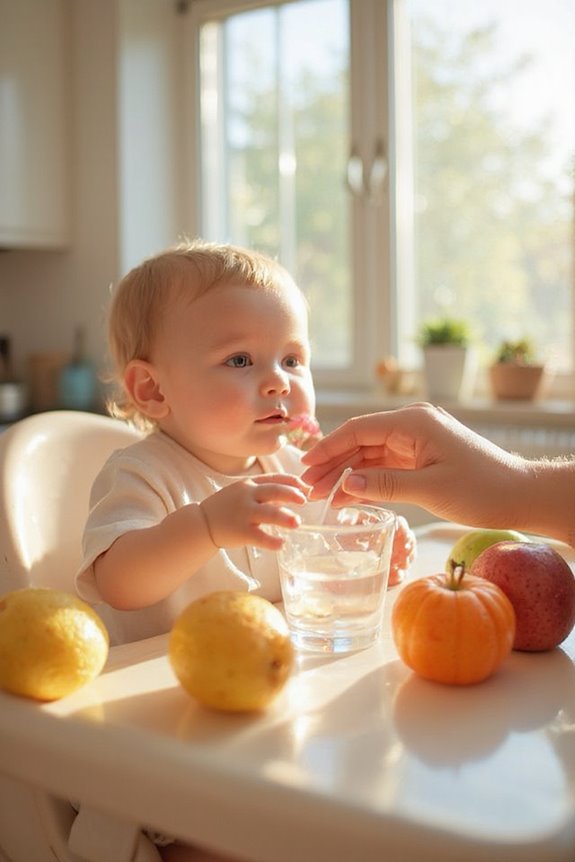
As we embark on the journey of introducing water to our infants, it’s essential to consider various safety aspects to ensure their health and well-being. While hydration myths may suggest that all water is safe, it’s crucial to be mindful of our water sources.
Here are some key safety considerations:
- Age: Introduce water around six months, but continue prioritizing breast milk or formula.
- Quality: Use clean, low-fluoride water, and test for contaminants regularly.
- Watch for Signs: Monitor for dehydration or overhydration; signs might include dry mouth or excessive vomiting.
- Volume Control: Limit water amounts to avoid overhydration.
Benefits of Introducing Water

Introducing water to our infants can be an exciting milestone, especially since it offers numerous benefits for their health and development. The hydration benefits are significant; water aids in nutrient transport, helping to deliver essential vitamins and minerals to their growing bodies. It also promotes healthy digestion and helps regulate body temperature, crucial for our little ones.
Monitoring Water Intake
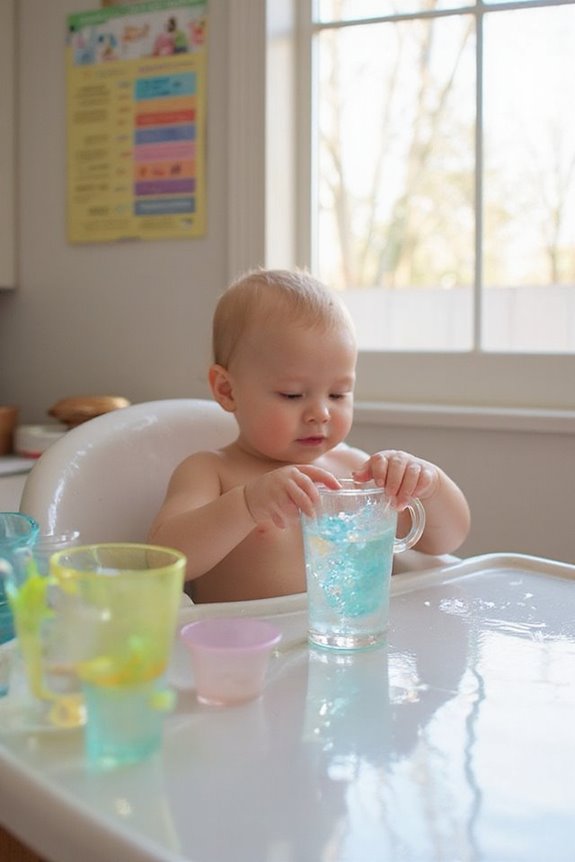
Monitoring your baby’s water intake is just as important as introducing it in the first place. After six months, we can start tracking consumption to ensure our little ones stay safe and healthy. Here are some key points to consider:
- Limit daily water intake to 4-8 ounces before they reach 12 months.
- Offer water in an open cup or straw cup, rather than a bottle.
- Be mindful of the frequency of offerings to prevent overhydration.
While monitoring symptoms, watch for signs of excessive water consumption, such as vomiting or lethargy. If we notice any concerning symptoms, reaching out to a pediatrician can provide peace of mind. By staying vigilant, we help our babies thrive during this exciting stage.
Nutritional Prioritization: Milk First
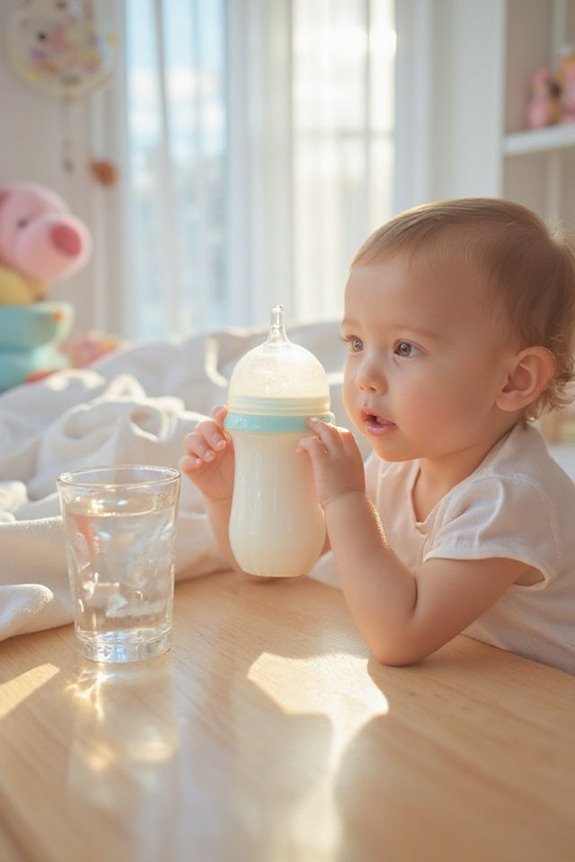
When we think about our babies’ nutrition, it’s essential to remember that milk should take the lead during their first year. Milk provides the necessary hydration and vital nutrients for optimal infant growth. Here’s why prioritizing milk nutrition is crucial:
- Primary Source: Milk meets all nutritional needs for the first six months.
- Hydration: With about 87% water, both breast milk and formula hydrate effectively.
- Electrolyte Balance: Milk maintains a proper balance that water alone can’t offer.
- Growth Support: Adequate milk intake supports healthy development.
As we introduce water around six months, let’s be clear: it should never replace milk. Instead, we can use it as a supplemental hydration tool, ensuring our little ones continue to thrive.
Consulting Healthcare Professionals

How can we ensure our little ones stay hydrated without compromising their nutrition? Consulting healthcare professionals is vital when introducing water. Following pediatric advice, we should consider starting at 6 months, allowing up to 8 ounces daily. Here are some key points to keep in mind:
- Monitor wet diapers and energy levels to assess hydration.
- Offer water in an open or straw cup to cultivate those cup-drinking skills.
- If we have hydration concerns or notice persistent coughing, reaching out to our pediatrician is essential.
Frequently Asked Questions
Can I Give My Baby Flavored Water?
We know it’s tempting to give our baby flavored water, but let’s avoid it for now. Instead, let’s stick to breast milk or formula for hydration, following baby hydration tips for their health and safety.
What Types of Cups Are Best for Babies?
When choosing cups for our little ones, we love sippy cups for their spill-proof design and training cups that help them learn. Both options make drinking fun while supporting their growing independence. Let’s explore together!
How Can I Tell if My Baby Is Dehydrated?
As we gaze at our little ones, let’s watch for signs of dehydration: fewer wet diapers, dark urine, and dry mouths. Staying informed with hydration tips helps keep our precious babies healthy and happy together.
Is It Safe to Add Electrolyte Solutions to Water?
We understand your concern about hydration needs. While electrolyte benefits can be crucial, we shouldn’t add them to water for infants unless a doctor prescribes it. Let’s prioritize their safety and stick to plain water first.
Can My Baby Drink Sparkling Water?
When it comes to sparkling water safety, we shouldn’t introduce it to our baby. Instead, let’s focus on proper hydration with breast milk or formula, ensuring our little one stays safe and healthy.

